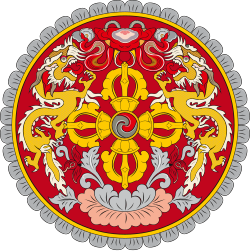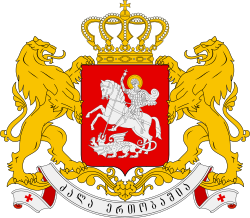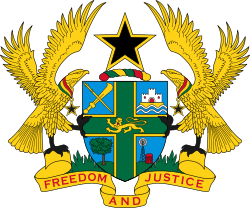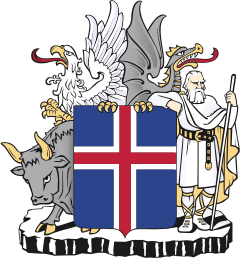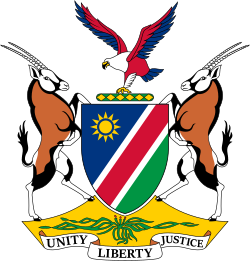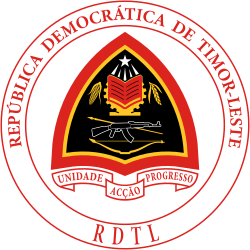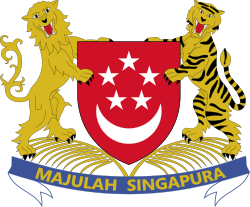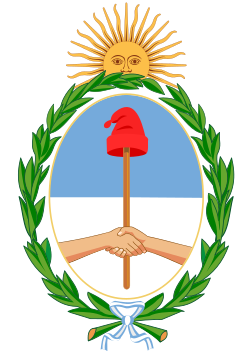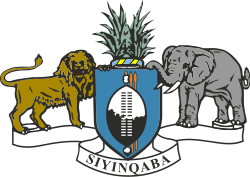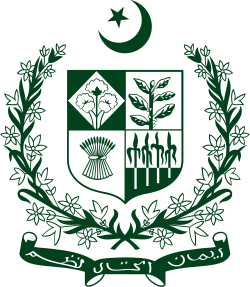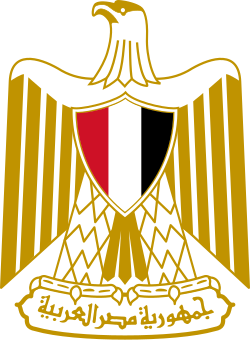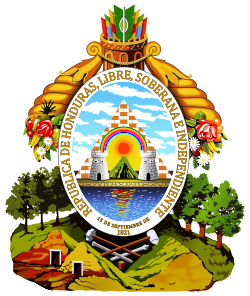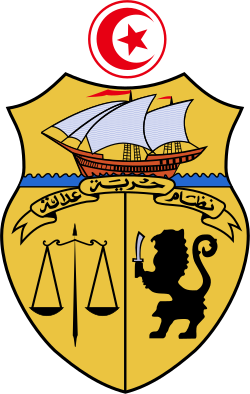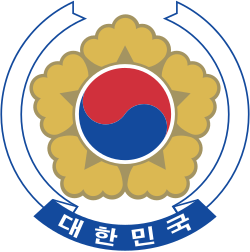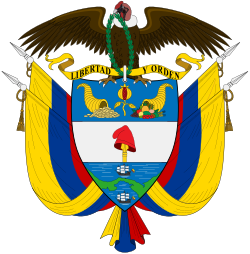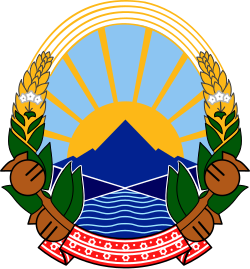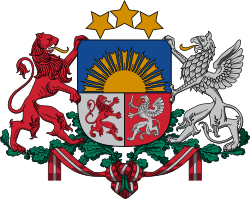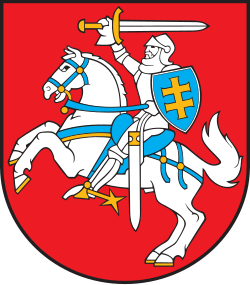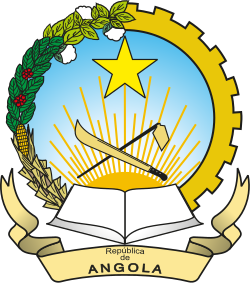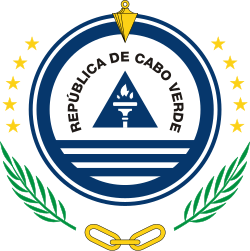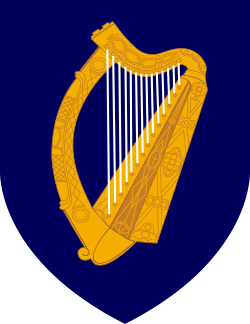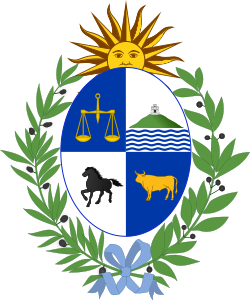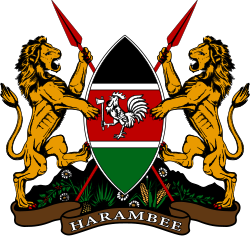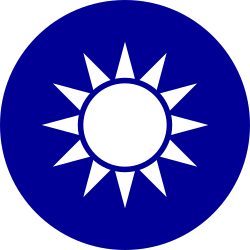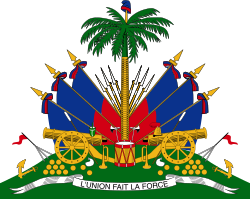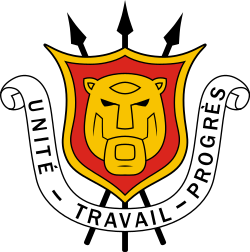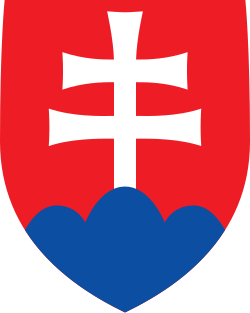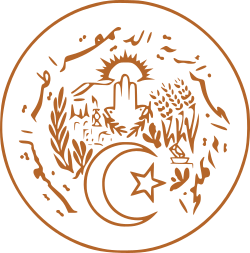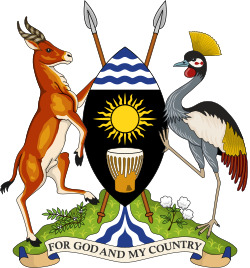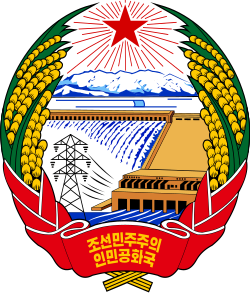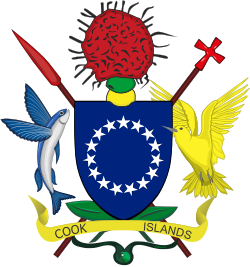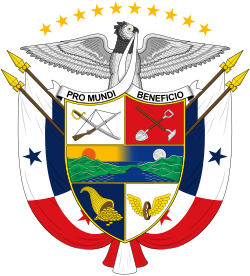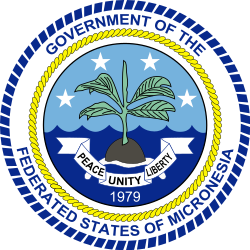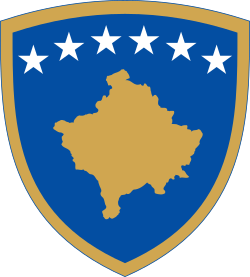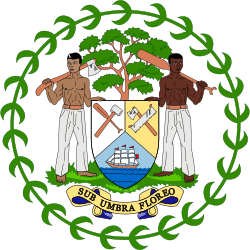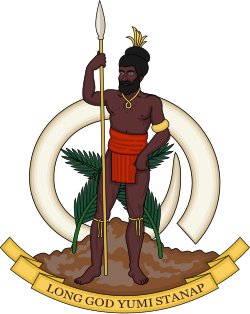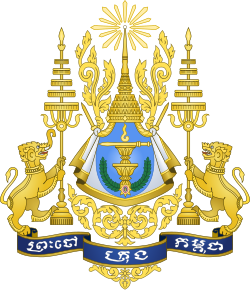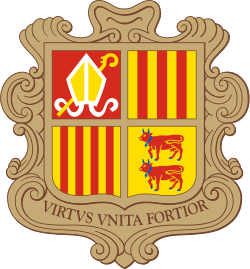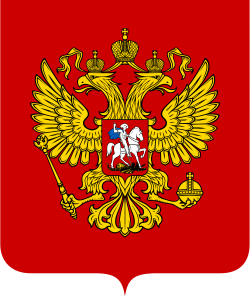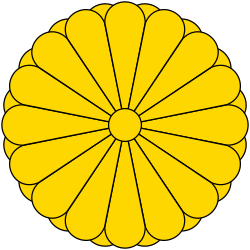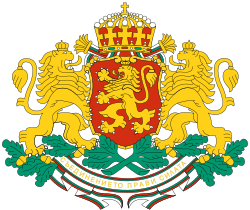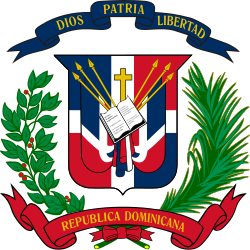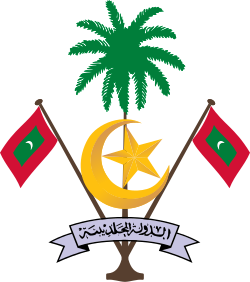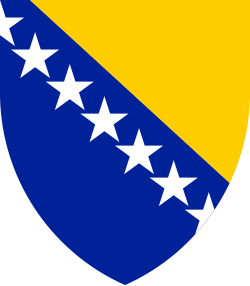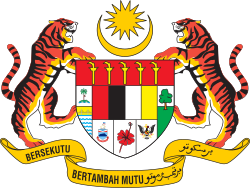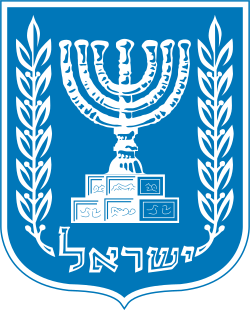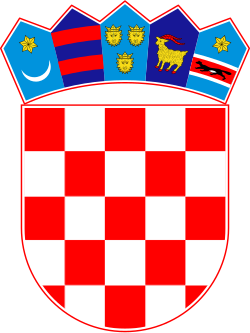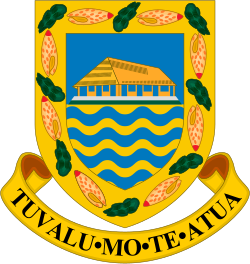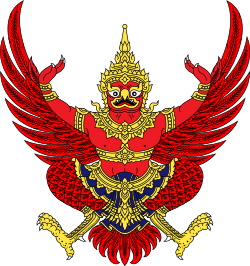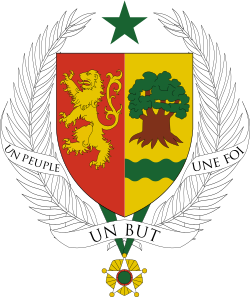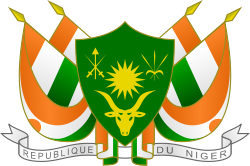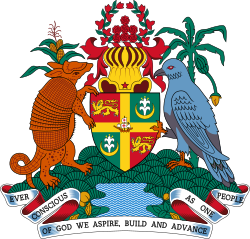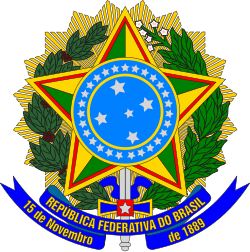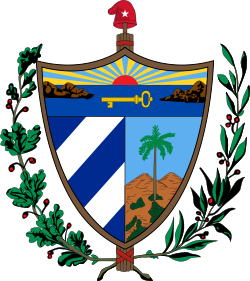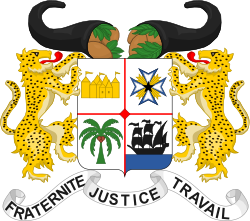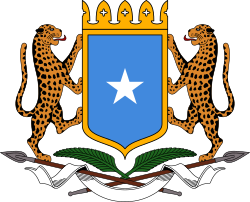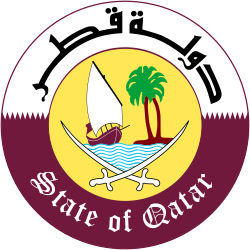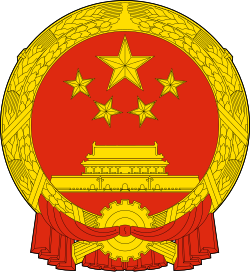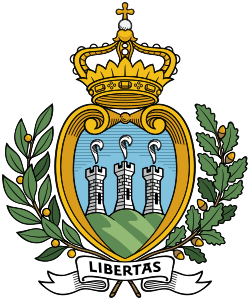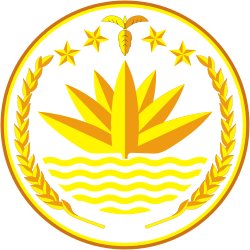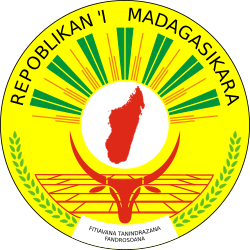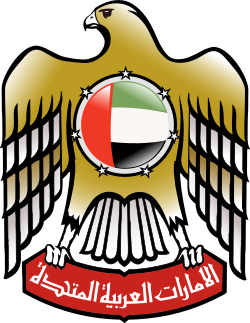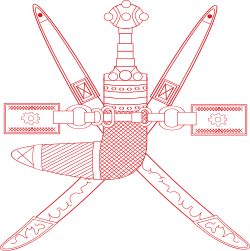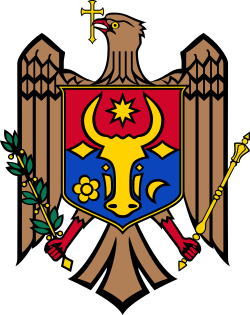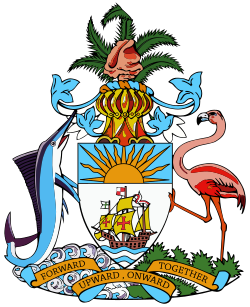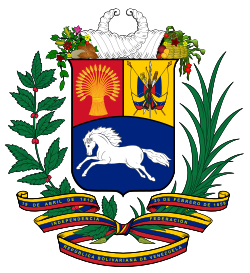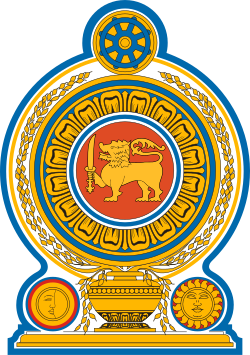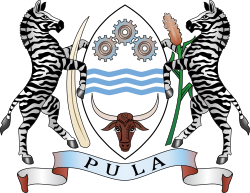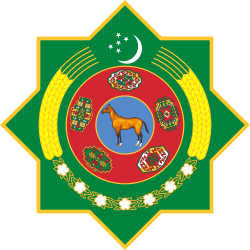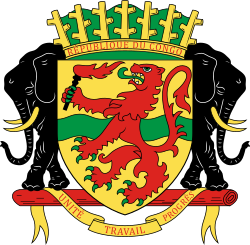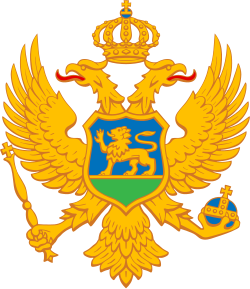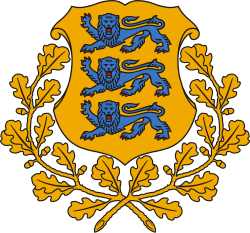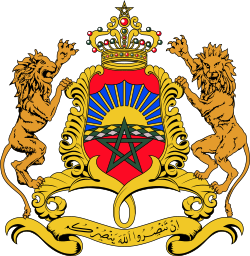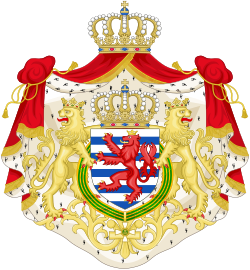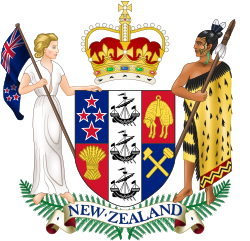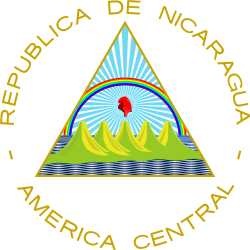Liste der Nationalwappen
Die Liste der Nationalwappen enthält die Staatswappen aller 193 Mitgliedstaaten der Vereinten Nationen sowie die Wappen jener Staaten, die mindestens von einem UN-Mitglied als unabhängig anerkannt sind. Dies sind derzeit: Abchasien, die Demokratische Arabische Republik Sahara (Westsahara), der Kosovo, Palästina, Südossetien, Republik China (Taiwan), die Türkische Republik Nordzypern, die Cookinseln, Niue und Vatikanstadt. Die Namen der Nicht-UN-Staaten sind in Kursivschrift angegeben.
Eine entsprechende Liste von Flaggen lässt sich unter Liste der Nationalflaggen finden. Unter der Liste der Flaggen und Wappen nichtselbständiger Gebiete sind die Nationalflaggen und -wappen von abhängigen Territorien aufgelistet.
A
B
C
D
E
F
G
H
I
J
K
L
M
N
O
P
R
S
- (c) Xavi Garcia, CC BY-SA 3.0
- (c) Xavi Garcia, CC BY-SA 3.0
T
U
V
W
Z
Siehe auch
- Liste der Nationalflaggen
- Liste der Flaggen und Wappen von De-facto-Regimen
- Liste der Staaten der Erde
Weblinks
Auf dieser Seite verwendete Medien
Wappen von Aserbaidschan
Emblem of Bhutan — used by the Parliament of Bhutan, first established in 2007.
Autor/Urheber: Dessiné par Jérôme BLUM le 5 septembre 2007. Készítette: Jérôme BLUM 2007., Lizenz: CC BY-SA 2.0 fr
unofficial emblem of the French Republic, created from France coa.png. The only official emblem of France is its tricolour flag.
Coat of Arms of the Republic of Ghana, adopted on 4 March 1957
Wappen von Island
Autor/Urheber: Sodacan, Lizenz: CC BY-SA 3.0
Royal Coat of Arms of the Netherlands
East Timor Coat Of Arms
Great coat of arms of Sweden
Wappen Portugals
Seal of Mauritania
Coat of arms of Argentina
Seal of the Republic of the Marshall Islands.
Autor/Urheber:
Republik Südafrika
, Lizenz: PD-Amtliches WerkWappen Südafrikas
Wappen von Eswatini
The coat of arms of Honduras was created on October 3, 1825. Dionisio Herrera, as the Head of State of Honduras, decreed through his initiative, Honduras acquired its own national shield, one which represents Honduran history and the rich variety of national resources that it possesses and which should be protected and conserved. The National Congress thereby declared in its decree #16 and article 142, designated the shield as a national symbol for all uses, in a clear and general manner. The National Congress approved this in Tegucigalpa on January 10, 1935. (http://www.honduras.com/official/)
The National Congress decrees:
Article 1 - The National Coat of Arms that shall be used is an equilateral triangle. On its base is a volcano between two castles, over them is a rainbow and below it [and] behind the volcano a sun rises spreading light. The triangle [is] placed over land which appears to be bathed by both seas [Atlantic and Pacific]. Around it an oval containing in gold lettering: "REPUBLICA DE HONDURAS, LIBRE, SOBERANA E INDEPENDIENTE. 15 DE SEPTIEMBRE DE 1821" [Republic of Honduras, Free, Sovereign and Independent. 15th September 1821] On the top part of the oval there is a quiver full of arrows from which hang horns of plenty joined with a knot resting over a mountain range from which clearly stand three oak trees on the right hand side and three pine trees on the left, and mines, a bar, a drill, a wedge, a sledgehammer and a hammer [all] distributed as appropriate. (http://flagspot.net/flags/hn).html)Autor/Urheber: Simi Tukidia, Lizenz: CC BY-SA 3.0
This is a vector image of the Fiji Coat of Arms re-created in Adobe Illustrator software
Coat of arms of Malta.
Autor/Urheber: Sodacan, Lizenz: CC BY-SA 4.0
National Emblem of Papua New Guinea (Adopted on 1 July 1971)
| “ | DESCRIPTION OF THE NATIONAL EMBLEM (National Identity Act 1971)
The Papua New Guinea National Emblem is a partiaIIy-stylized representation of the widespread Bird of Paradise Genus paradisaea in display, head turned to its left, seated on the upturned grip of a horizontal Kundu drum with the drum-head to the right side of the bird, from behind which a horizontal ceremonial spear projects with the head to the left of the bird. If coloured proper, the following colours should be used -- BIRD OF PARADISE
SPEAR
KUNDU DRUM
|
” |
Autor/Urheber: Neville C. Connell, director of the Barbados Museum, Lizenz: CC BY-SA 3.0
The Coat of Arms of Barbados.
Arms: Or a bearded Fig Tree eradicated in chief two Red Pride of Barbados Flowers proper.
Crest: On a Wreath Or and Gules A dexter Cubit Arm of a Barbadian erect proper the hand grasping two Sugar Canes in saltire proper.
Supporters: On the sinister (left) side a Dolphinfish and on the dexter (right) side a Pelican proper.
Motto: “Pride and Industry.”Wappen der Republik Kolumbien.
Das Wappen Kolumbiens wurde am 9. Mai 1834 eingeführt und zuletzt am 9. November 1924 geringfügig verändert.
Beschreibung:„Das Wappen ist zweimal geteilt und zeigt oben in Blau einen goldenen gestielten Granatapfel begleitet von je einem goldenen Füllhorn rechts goldene Münzen und links Früchte streuend. Mittig in Silber eine rote Phrygische Mütze auf goldener Lanzenspitze gesteckt. Unten in Blau zwei dreimastige Rahsegler mit weißen gesetzten Segeln und mit Landesfahne am Heck rechtsfahrend durch eine grüne Landzunge getrennt. Zu beiden Seiten des Wappens je zwei Landesfahnen in den Farben Gelb-Blau-Rot mit silbernen Stangenspitzen und goldenen Kordeln. Auf dem Schild sitzt der natürlich gefärbte Kondor mit ausgebreiteten Schwingen und hält im Schnabel den Schild an einer grünen Kordel, die durch einen silbernen Ring geführt ist. Ein goldenes Schriftband mit schwarzen Majuskel die Devise „LIBERTAD Y ORDEN" zu seinen Fängen.“
Turkey has no official coat of arms, this star and crescent is being used on passports, ID cards, driving licences, embassy signs, seal of the presidential office, seal of the TBMM and the seal of the Ministry of Foreign Affairs.
Emblem of Yemen. From http://www.brandsoftheworld.com/search/93446021/113560.html
Coat of arms of Latvia.
Coat of Arms of the Hashemite Kingdom of Jordan during the reign of King Hussein. Inscription on the scroll comprises three phrases. On the right side is “Al Hussein bin Talal bin Aoun” (Aoun is the great grandfather of Al Sharif Al Hussein bin Ali); in the middle is “King of the Hashemite Kingdom of Jordan”; on the left side: “Who seeks support and guidance from God.”
Arms of Ireland. Blazon: Azure, a harp or stringed argent. With 14 strings shown.
The National Emblem of India is derived from the time of the Emperor Ashoka. The emblem is a replica of the Lion of Sarnath, near Varanasi in Uttar Pradesh. The Lion Capital was erected in the third century BC by Emperor Ashoka to mark the spot where Buddha first proclaimed his gospel of peace and emancipation to the four quarters of the universe. The national emblem is thus symbolic of contemporary India’s reaffirmation of its ancient commitment to world peace and goodwill. The four lions(one hidden from view ) – symbolising power, courage and confidence- rest on a circular abacus. The abacus is girded by four smaller animals—Guardians of the four directions: The Lion of the North, The Horse of the West, The Bull of the South and The Elephant of the East. The abacus rests on a lotus in full bloom, exemplifying the fountainhead of life and creative inspiration. The motto 'Satyameva Jayate' inscribed below the emblem in Devanagari script means 'truth alone triumphs'.
National Seal of the Comoros.
Arabic text reads جمهورية القمر المتحدة Jumhuriyat al-Qamar al-Muttaḥidah.
Coat of arms of Seychelles adopted on 18 June 1996.
Heraldic description of the Armorial Bearings of the Republic of the Seychelles:
- ARMS: Azure, a Female Coco de Mer Palm (Lodoicea maldivica) issuant from the base a grassy mount thereon a Giant Tortoise (Testudo gigantea) the whole in front of water rising therefrom to the dexter an Island and sailing thereon a two-masted Schooner in full sail all proper.
- CREST: Upon a wreath Azure, Or, Gules, Argent and Vert above water barry wavy Azure and Argent a White Tailed Tropic Bird (Phaeton lepturus lepturus) volant proper.
- SUPPORTERS: On either side a Sail Fish (Istiophorus gladius) proper
- MOTTO: "FINIS CORONAT OPUS" (can be loosely translated as "The End Crowns the Work".)
Autor/Urheber: Ashiriz, Lizenz: CC BY-SA 3.0
Coat of Arms of The Republic of kenya
Staatswappen der Republik China
Autor/Urheber:
- derivative work: Pbroks13 (talk)
- New-TRNC-coa.GIF: Expatkiwi
The Turkish Republic of Northern Cyprus Coat of Arms.
Coat of arms of the Republic of Burundi.
Autor/Urheber: Yashveer Poonit, Lizenz: CC BY-SA 3.0
The armorial ensigns and supporters of Mauritius are described as:
(a) for arms-
- Quarterly azure and or.
- In the first quarter a lymphad or.
- In the second, 3 palm trees vert.
- In the third, a key in pale the wards downwards gules.
- In the issuant, from the base a pile, and in chief a mullet argent.
(b) for the supporters-
- On the dexter side, a dodo per bend sinister embattled gules and argent, and
- On the sinister side, a sambur deer per bend embattled argent and gules, each supporting a sugar cane erect proper,
Wappen der Slowakei
Autor/Urheber: extracted from the flag of Brunei, provided at the Open Clip Art website., Lizenz: CC0
Emblem of Brunei.
Wappen Serbien
Logo of the Ministry of Energy and Mining in Algeria
Autor/Urheber: Sodacan, Lizenz: CC BY-SA 3.0
Coat of Arms of the of Uganda
| “ | An achievement was adopted by the National Council, three weeks before the proclamation of independence. On 1 October 1962 it was approved by the Governor and fixed by law on 9 October. The achievement is:
|
” |
SVG version of the South Sudan Coat of Arms, drawn from the low-res png version available at this time.
The Coat of arms of the Democratic Republic of the Congo since 2006
Autor/Urheber: BaronJaguar, Lizenz: CC BY 4.0
Coat of arms of Trinidad and Tobago (2025 revision)
Autor/Urheber: Sodacan, Lizenz: CC BY-SA 3.0
Coat of Arms of the Republic of Malawi, adopted upon independence in 1964. A Royal Warrant granted by Queen Elizabeth II, reads:
- Arms: Tierce per fess: 1. Barry wavy of four Azure and Argen; 2. Gules, a lion passant Or; 3. Sable, a rising sun radiant Or.
- Crest: On a steel helmet to the dexter, lambrequined Or and Gules, a rising sun radiant Or, charged with a fish eagle hovering above two waves Azure, proper.
- Supporters: A lion on the dexter and a panther on the sinister proper.
- Compartment: Mount Mlanje proper.
- Motto: UNITY AND FREEDOM, in black lettering on a ribbon Or.
The national coat of arms of Slovenia. Slovenias Coat of Arms defines three stars that represent the Counts of Celje, Triglav mountain and Adriatic sea.
Autor/Urheber: Josedar, Lizenz: CC BY-SA 4.0
Coat of arms of the Cook Islands
Autor/Urheber: SanchoPanzaXXI, Lizenz: CC BY-SA 4.0
National coat of arms of Eritrea. Colors after [1]
Wappen Gabuns
The coat of arms of Palestine — standard pan-Arab "Eagle of Saladin" with shield of the flag, and holding a scroll with the word Filasṭīn
Autor/Urheber: Original design by Nicholas Potin, vectorised by user:Fenn-O-maniC, Lizenz: CC BY-SA 3.0
Coat of arms of Gambia
Emblem of Vietnam. Blazon: On a roundel Gules, a mullet Or of the field, in base a cogwheel of ten teeth also Or; surrounded by two garbs of rice Or, each of five ears and fifty-four grains, tied by a ribbon Gules fimbriated Or and inscribed with the words CỘNG HOÀ XÃ HỘI CHỦ NGHĨA in chief and VIỆT NAM in base, all letters Or.
Autor/Urheber: Government of the Republic of Kosovo (current image) Cradel (old current version), earlier versions by Aotearoa and B1mbo, Lizenz: CC BY-SA 3.0
Emblem of the Republic of Kosovo
Coat of arms from Antigua and Barbuda, retraced to SVG
Coat of arms of Belize
Wappen von Belarus
Autor/Urheber: Sodacan, Lizenz: CC BY-SA 3.0
Coat of arms of Vanuatu, adopted 30 July 1980
Royal Arms of the Kingdom of Cambodia.
- Depicting: a Golden sword atop two ceremonial bowls, above it is the sacred "Aum", below is a laurel wreath and the Royal Order. The Arms is supported by two creatures, a gajasingha and a singha, they are holding two five-tiered royal umbrellas. Atop the arms is the Royal crown with rays of light emitting from it. Below is a ribbon with the words in Khmer script: ព្រះចៅ ក្រុង កម្ពុជាPreah Chau Krong Kampuchea: "King of the Kingdom of Cambodia".
Autor/Urheber: Prez001, Lizenz: CC BY-SA 3.0
Another variant of the Coat of Arms of Côte d'Ivoire seen in use here: http://www.gouv.ci/Main.php
This version has very stylized trees, and the gold is much darker. Also the gold doesn't extend to the rays of the sun.
I think there are lots of versions going around that is concurrently being used officially, mostly based on which version is readily available at the time an image of the coat of arms is needed.Coat of arms of Iraq as adapted to new 2008 form of national flag -- standard pan-Arab "Eagle of Saladin" with shield of the tricolor of national flag (with the "Takbir" الله أكبر in Kufic text, as on the flag), holding a scroll with the words جمهورية العراق; (Jumhuriyat al-`Iraq "The Republic of Iraq").
Wappen der Republik Österreich (Bundeswappen): Österreichisches Staatswappen in der offiziellen Version entsprechend dem Bundesgesetz vom 28. März 1984 über das Wappen und andere Hoheitszeichen der Republik Österreich (Wappengesetz), BGBl. Nr. 159/1984.
Das ursprüngliche Staatswappen wurde in der ersten Republik Österreich im Jahr 1919 eingeführt. Im austrofaschistischen Ständestaat wurde es im Jahr 1934 wieder abgeschafft und, im Rückgriff auf die österreichisch-ungarische Monarchie, durch ein Wappen mit Doppeladler ersetzt. In der wiedererstandenen (zweiten) Republik im Jahr 1945 wurde das Bundeswappen mit dem Wappengesetz in der Fassung StGBl. Nr. 7/1945 in modifizierter Form wieder eingeführt. Es versinnbildlicht, diesem Gesetzestext entsprechend (Art. 1 Abs. 1), „die Zusammenarbeit der wichtigsten werktätigen Schichten: der Arbeiterschaft durch das Symbol des Hammers, der Bauernschaft durch das Symbol der Sichel und des Bürgertums durch das Symbol der den Adlerkopf schmückenden Stadtmauerkrone […]. Dieses Wappen wird zur Erinnerung an die Wiedererringung der Unabhängigkeit Österreichs und den Wiederaufbau des Staatswesens im Jahre 1945 dadurch ergänzt, dass eine gesprengte Eisenkette die beiden Fänge des Adlers umschließt.“
Autor/Urheber:
- Lion héraldique.svg - Bluebear2
- Heraldique meuble lion passant.svg - Rinaldum, S@m, Zigeuner
- Coat of arms of Haiti (1964-1986).svg - Thommy9
- abgeleitetes Werk: Yuma
free version of the Sierra Leone CoA
Coat of arms of the Dominican Republic
Autor/Urheber: See File History, below, for details., Lizenz: Attribution
Coat of arms of Dominica
Coat of Arms of the Maldives
Coats of arms of Suriname
State emblem of Indonesia is called Garuda Pancasila. The main part of the coat of arms is the golden mythical bird Garuda with a shield on its chest and a scroll gripped by its leg bears the national motto: "Bhinneka Tunggal Ika", roughly means "Unity in Diversity". The shield's five emblems represent Pancasila, the five principles of Indonesia's national philosophy. The numbers of feathers was meant to symbolize the date of Indonesian Proclamation of Independence; 17 feathers on each wings, 8 tail feathers, 19 upper tail feathers (under the shield, above the tail), and 45 neck feathers; all symbolize 17-8-1945; 17th August 1945. Garuda Pancasila was designed by Sultan Hamid II of Pontianak, and was adopted as national coat of arms on February 11, 1950.
Commonwealth Coat of Arms of Australia granted by Royal Warrant signed by King George V on 19 September 1912.
IMPORTANT:This image is an artist's interpretation of the original (1912) official version of the Commonwealth Coat of Arms shown in Commons on the Australian coat of arms page. A variant of the original, with a transparent background, is shown on this page.
| “ | Quarterly of six, the first quarter Argent a Cross Gules charged with a Lion passant guardant between on each limb a Mullet of eight points Or; the second Azure five Mullets, one of eight, two of seven, one of six and one of five points of the first (representing the Constellation of the Southern Cross) ensigned with an Imperial Crown proper; the third of the first a Maltese Cross of the fourth, surmounted by a like Imperial Crown; the fourth of the third, on a Perch wreathed Vert and Gules an Australian Piping Shrike displayed also proper; the fifth also Or a Swan naiant to the sinister Sable; the last of the first, a Lion passant of the second, the whole within a Bordure Ermine; for the Crest on a Wreath Or and Azure A Seven-pointed Star Or, and for Supporters dexter a Kangaroo, sinister an Emu, both proper. | ” |
Wappen von Israel.
Autor/Urheber: unknown, Lizenz:
Autor/Urheber: Denelson83, Lizenz: CC BY-SA 3.0
Coat of arms of Tuvalu. Manually drawn using an image in the World Flag Database as a reference. The words "Tuvalu mo te atua" are the first line of Tuvalu's national anthem. Translated: "Tuvalu for the Almighty" (see: en:Tuvalu_mo_te_Atua)
Autor/Urheber:
- Emblem_of_Kuwait.svg: RoyFocker 12
- derivative work: Pbroks13 (talk)
State emblem of Kuwait, with inscription دولة الكويت dawlat al-kuwayt "State of Kuwait".
Wappen Griechenlands seit 7. Juni 1975.
National Emblem of Thailand, depicting a dancing Garuda with outstretched wings. The Garuda symbolizes the government and people of Thailand, as Lord Vishnu symbolizes King of Thailand.
Autor/Urheber: Prez001, Lizenz: CC BY-SA 3.0
Coat of Arms of St Vincent and the Grenadines.
Autor/Urheber: Turn685, Lizenz: CC BY-SA 3.0
The present coat of arms of Guinea was adopted in 1984 and features a dove with a golden olive branch in its beak over a ribbon with "Work justice solidarity". The arms formerly also included a crossed sword and rifle. Previous arms in 1958 featured a red and yellow shield with a green elephant on it.
Autor/Urheber: Pbroks13 (talk), Lizenz: CC BY-SA 3.0
Coat of arms of Niger
Autor/Urheber: Sodacan, Lizenz: CC BY-SA 4.0
Coat of arms of Grenada, adopted in the summer 1974 following independence.
| “ | Quarterly, a cross Or, 1 & 4: Gules, a lion passant guardant Or, 2 & 4: Vert, a crescent and a lily Or; and in nombril point a picture of the Santa Maria. For a crest a golden helmet guardant, lambrequined Gules and with a wreath Argent and Gules, seven red roses surrounded with a garland of Bougainvillea-flowers. For supporters an armadillo (Tolypeutes tricinctus – Dasypodidæ) on the dexter, supporting a stalk of maize, and a Grenada dove (Leptotila wellsi) on the sinister, supporting a banana tree. On a ribbon an motto: EVER CONSCIOUS OF GOD WE ASPIRE, BUILD AND ADVANCE AS ONE PEOPLE. As a compartment the Mount St. Catherine and the lake Grand Étang. | ” |
Coat of arms of Liechtenstein
Autor/Urheber: Josedar, Lizenz: CC BY-SA 4.0
Coat of arms of São Tomé and Príncipe
Coat of Arms of Nauru. Nauru has no known intellectual property law so this is in the Public Domain
Autor/Urheber: Tinynanorobots, Fenn-O-maniC, Lizenz: CC BY-SA 3.0
Coat of arms of Benin
Variant of the State Seal of Myanmar
Current coat of arms of Liberia, adopted 1963
Autor/Urheber: Borb, modified by User:Di (they-them), Lizenz: CC BY-SA 4.0
Coat of arms of Cyprus since 2006
Coat of arms of Lesotho from 2006.
Emblem of Qatar (1976–2022)
Coat of arms of El Salvador
- The coat of arms has the words (REPÚBLICA DE EL SALVADOR EN LA AMÉRICA CENTRAL) in a bold and Heavy, Sans Serif Boris Black Bloxx typeface, in a golden amber color
- The nacional motto (DIOS UNIÓN LIBERTAD) in bold version of Trajan (typeface), Roman type, Roman square capitals. The letters are colored black within a golden amber scroll.
- The date (15 DE SEPTIEMBRE DE 1821) in bold version of Trajan (typeface), Roman type, Roman square capitals.
Staatswappen der Volksrepublik China
Coat of arms of Mali
Autor/Urheber: Diafora, Lizenz: CC BY-SA 3.0
Coat of Arms of Saint Lucia
| “ | The ROSE which you see on the coat of arms tells us about England. At one time England was our “mother” country because she was in charge of our affairs. The FLEUR-DE-LIS reminds us that we belonged to France as many as seven times. The Bamboo is our national plant, two pieces form the cross of the shield. The little AFRICAN STOOL in the centre is African and reminds us of our ancestors who were shipped from Africa during the slave trade. To light us on our way, we have a TORCH which is held up high. The Saint Lucian Parrot Amazona versicolor is our national bird guards each side of the Coat of Arms. Our Motto “THE LAND, THE PEOPLE, THE LIGHT”, is printed at the bottom of the shield. | ” |
Autor/Urheber:
- Coat_of_arms_of_Saint_Kitts_and_Nevis_1983_variant.png: Original uploader was at de.wikipedia
- Coat_of_arms_of_Saint_Kitts_and_Nevis_1983.svg:
- derivative work: Snubcube (talk)
Coat of arms of Saint Kitts and Nevis, modified in 1983 after the withdrawal of Anguilla.
Coat of arms of Equatorial Guinea
Sila ʻo Tonga — Coat of arms of the Kingdom of Tonga
Coat of arms of Zambia
Simplified image of arms of Poland; the official arms can be seen at: Coat of arms of Poland-official.png
The State Emblem of the Kyrgyz Republic.
Autor/Urheber: Prez001, Lizenz: CC BY-SA 3.0
Coat of arms of the Solomon Islands.
Seal of Madagascar
Emblem of the United Arab Emirates (from 2008)
Autor/Urheber: Host09, Lizenz: CC BY-SA 3.0
Escudo de España: El Escudo de España es cuartelado y entado en punta. En el primer cuartel, de gules o rojo, un castillo de oro, almenado, aclarado de azur o azul y mazonado de sable o negro. En el segundo, de plata, un león rampante, de púrpura, linguado, uñado, armado de gules o rojo y coronado de oro. En el tercero, de oro, cuatro palos, de gules o rojo. En el cuarto, de gules o rojo, una cadena de oro, puesta en cruz, aspa y orla, cargada en el centro de una esmeralda de su color. Entado de plata, una granada AL NATURAL, rajada de gules o rojo, tallada y hojada de dos hojas, de sinople o verde. Acompañado de dos columnas, de plata, con base y capitel, de oro, sobre ondas de azur o azul y plata, superada de corona imperial, la diestra, y de una corona real, la siniestra, AMBAS DE ORO, y rodeando las columnas, una cinta de gules o rojo, cargada de letras de oro, en la diestra "Plus" y en la siniestra "Ultra". Al timbre, corona real, cerrada, que es un círculo de oro, engastado de piedras preciosas, compuesto de ocho florones de hojas de acanto, visibles cinco, interpoladas de perlas, y de cuyas hojas salen sendas diademas sumadas de perlas, que convergen en un mundo de azur o azul, con el semimeridiano y el ecuador de oro, sumado de cruz de oro. La corona, forrada de gules o rojo. Artículo segundo El Escudo de España, tal como se describe en el artículo anterior, lleva escusón de azur o azul, tres lises de oro, puestas dos y una, la bordura lisa, de gules o rojo, propio de la dinastía reinante. Ley 33/1981, de 5 de octubre, del Escudo de España Elementos SVG:
Coat of arms of the Sahrawi Arab Democratic Republic
Coat of arms of Abkhasia
Coat of arms of Guatemala
Coat of arms of the Philippines
Autor/Urheber: See File history below for details., Lizenz: OGL-om 1.0
National emblem of Oman
Autor/Urheber:
- Coat of arms of the Vatican City.svg: Cronholm144, Hautala, F l a n k e r
- abgeleitetes Werk: Gambo7
- Reference used
- The original design is attributed to the Vatican City in Rome and an unknown artist.
Coat of arms of the Vatican City.
Coat of arms of the Bahamas, mantling doubled argent (white)
Coat of arms of Venezuela
National emblem of Sri Lanka
Autor/Urheber: F l a n k e r, Lizenz: CC BY-SA 3.0
coat of arms of Burkina Faso.
(c) Sodacan, Katepanomegas, CC BY-SA 3.0
Großes Wappen des Königreichs Belgien
The Emblem of Turkmenistan with realistic image of the horse (Yanardag with white spots on its legs). This version is used in present on 2012 http://tax.gov.tm/. Colors are in accordance with the Regulations about the State Emblem of Turkmenistan on August 25, 2003, clause 3 (Russian text - http://base.spinform.ru/show_doc.fwx?rgn=25217).
Wappen der Republik Kongo (1963 bis 1969 und erneut seit 1991)
Coat of arms of Montenegro (adopted on 13 July 2004)
Current (1986) version of the coat of arms of Cameroon, a modified version of the original design adopted 1960...
Emblem of Saudi Arabia
Autor/Urheber: Simitukidia, Lizenz: CC BY-SA 3.0
This is a vector image of the Samoa Coat of Arms re-created in Adobe Illustrator software
Public Seal of Niue
(c) Katepanomegas, CC BY-SA 3.0
Greater coat of arms of the grand-duchy of Luxembourg
| “ | Art.1er. Les armoiries du Grand-Duché de Luxembourg sont à trois échelons :
Art. 2. Les armoiries désignées à l’article 1er ci-dessus se composent des éléments héraldiques suivants :
|
” |
Autor/Urheber: Sodacan, Lizenz: CC BY-SA 3.0
Staatswappen Neuseelands (seit 1956).
- Das Staatswappen zeigt einen in Blau und Rot gevierten Schild mit einem silbernen Pfahl. Es zeigt im blauen ersten Feld das Kreuz des Südens (Southern Cross) mit silbergeränderten fünfzackigen Sternen als Symbol des Staates und im blauen vierten Feld goldene Bergmannswerkzeuge, Symbole für Landwirtschaft, Viehzucht und Bergbau, sowie ein Goldenes Vlies im roten zweiten Feld und im dritten Feld in Rot eine goldene Korngarbe. Die drei schwarzen nach rechts fahrende Segelschiffe mit ausliegenden Rudern im Pfahl stehen für die Bedeutung des Seehandels und für die Besiedlung Neuseelands vom Meer her. Der Wappenschild wird links von einer weißen Frau mit der Flagge Neuseelands in der Hand, Symbol für die europäischen Einwanderer, und rechts von einem tätowiertem Māori im traditionellen Gewand, dem Kaitaka aus neuseeländischem Flachs, und mit einem Taiaha, einer langen Kampfkeule, in der Hand, Symbol für die Ureinwohner, als Schildhalter gehalten. Beide stehen auf Zweigen des Silberfarns, der Nationalpflanze. Darüber liegt ein silbernes Band mit dem Staatsnamen „NEW ZEALAND“. Über dem Wappenschild schwebt die britische Edwardskrone als Versinnbildlichung der formalen britischen Oberherrschaft.
Wappen von Laos
![Abchasien [Details]](http://upload.wikimedia.org/wikipedia/commons/thumb/8/80/Coat_of_arms_of_Abkhazia.svg/120px-Coat_of_arms_of_Abkhazia.svg.png)
![Ägypten [Details]](http://upload.wikimedia.org/wikipedia/commons/thumb/a/a6/Coat_of_arms_of_Egypt_%28Official%29.svg/120px-Coat_of_arms_of_Egypt_%28Official%29.svg.png)
![Albanien [Details]](http://upload.wikimedia.org/wikipedia/commons/thumb/6/6e/Coat_of_arms_of_Albania.svg/120px-Coat_of_arms_of_Albania.svg.png)
![Algerien [Details]](http://upload.wikimedia.org/wikipedia/commons/thumb/d/df/Emblem_of_Algeria.svg/120px-Emblem_of_Algeria.svg.png)
![Andorra [Details]](http://upload.wikimedia.org/wikipedia/commons/thumb/4/4e/Coat_of_arms_of_Andorra.svg/120px-Coat_of_arms_of_Andorra.svg.png)
![Angola [Details]](http://upload.wikimedia.org/wikipedia/commons/thumb/f/ff/Emblem_of_Angola.svg/120px-Emblem_of_Angola.svg.png)
![Äquatorialguinea [Details]](http://upload.wikimedia.org/wikipedia/commons/thumb/f/f8/Coat_of_arms_of_Equatorial_Guinea.svg/120px-Coat_of_arms_of_Equatorial_Guinea.svg.png)
![Antigua und Barbuda [Details]](http://upload.wikimedia.org/wikipedia/commons/thumb/3/30/Coat_of_arms_of_Antigua_and_Barbuda.svg/120px-Coat_of_arms_of_Antigua_and_Barbuda.svg.png)
![Argentinien [Details]](http://upload.wikimedia.org/wikipedia/commons/thumb/f/ff/Coat_of_arms_of_Argentina.svg/120px-Coat_of_arms_of_Argentina.svg.png)
![Armenien [Details]](http://upload.wikimedia.org/wikipedia/commons/thumb/0/0f/Coat_of_arms_of_Armenia.svg/120px-Coat_of_arms_of_Armenia.svg.png)
![Aserbaidschan [Details]](http://upload.wikimedia.org/wikipedia/commons/thumb/6/6b/Emblem_of_Azerbaijan.svg/120px-Emblem_of_Azerbaijan.svg.png)
![Australien [Details]](http://upload.wikimedia.org/wikipedia/commons/thumb/c/c5/Coat_of_arms_of_the_Commonwealth_of_Australia.svg/120px-Coat_of_arms_of_the_Commonwealth_of_Australia.svg.png)
![Bahamas [Details]](http://upload.wikimedia.org/wikipedia/commons/thumb/8/8a/Coat_of_arms_of_the_Bahamas.svg/120px-Coat_of_arms_of_the_Bahamas.svg.png)
![Bahrain [Details]](http://upload.wikimedia.org/wikipedia/commons/thumb/6/6d/Emblem_of_Bahrain.svg/120px-Emblem_of_Bahrain.svg.png)
![Bangladesch [Details]](http://upload.wikimedia.org/wikipedia/commons/thumb/8/81/National_emblem_of_Bangladesh.svg/120px-National_emblem_of_Bangladesh.svg.png)
![Barbados [Details]](http://upload.wikimedia.org/wikipedia/commons/thumb/b/bc/Coat_of_arms_of_Barbados_%282%29.svg/120px-Coat_of_arms_of_Barbados_%282%29.svg.png)
![Belarus [Details]](http://upload.wikimedia.org/wikipedia/commons/thumb/4/48/Coat_of_arms_of_Belarus_%282020%E2%80%93present%29.svg/120px-Coat_of_arms_of_Belarus_%282020%E2%80%93present%29.svg.png)
![Belgien [Details]](http://upload.wikimedia.org/wikipedia/commons/thumb/f/f1/Great_coat_of_arms_of_Belgium.svg/120px-Great_coat_of_arms_of_Belgium.svg.png)
![Belize [Details]](http://upload.wikimedia.org/wikipedia/commons/thumb/d/dd/Coat_of_arms_of_Belize.svg/120px-Coat_of_arms_of_Belize.svg.png)
![Benin [Details]](http://upload.wikimedia.org/wikipedia/commons/thumb/1/13/Coat_of_arms_of_Benin.svg/120px-Coat_of_arms_of_Benin.svg.png)
![Bhutan [Details]](http://upload.wikimedia.org/wikipedia/commons/thumb/e/eb/Emblem_of_Bhutan.svg/120px-Emblem_of_Bhutan.svg.png)
![Bolivien [Details]](http://upload.wikimedia.org/wikipedia/commons/thumb/0/06/Coat_of_arms_of_Bolivia.svg/120px-Coat_of_arms_of_Bolivia.svg.png)
![Bosnien und Herzegowina [Details]](http://upload.wikimedia.org/wikipedia/commons/thumb/d/d4/Coat_of_arms_of_Bosnia_and_Herzegovina.svg/120px-Coat_of_arms_of_Bosnia_and_Herzegovina.svg.png)
![Botswana [Details]](http://upload.wikimedia.org/wikipedia/commons/thumb/d/de/Coat_of_arms_of_Botswana.svg/120px-Coat_of_arms_of_Botswana.svg.png)
![Brasilien [Details]](http://upload.wikimedia.org/wikipedia/commons/thumb/b/bf/Coat_of_arms_of_Brazil.svg/120px-Coat_of_arms_of_Brazil.svg.png)
![Brunei [Details]](http://upload.wikimedia.org/wikipedia/commons/thumb/0/09/Emblem_of_Brunei.svg/120px-Emblem_of_Brunei.svg.png)
![Bulgarien [Details]](http://upload.wikimedia.org/wikipedia/commons/thumb/2/24/Coat_of_arms_of_Bulgaria.svg/120px-Coat_of_arms_of_Bulgaria.svg.png)
![Burkina Faso [Details]](http://upload.wikimedia.org/wikipedia/commons/thumb/9/96/Coat_of_arms_of_Burkina_Faso.svg/120px-Coat_of_arms_of_Burkina_Faso.svg.png)
![Burundi [Details]](http://upload.wikimedia.org/wikipedia/commons/thumb/f/fd/Coat_of_arms_of_Burundi.svg/120px-Coat_of_arms_of_Burundi.svg.png)
![Chile [Details]](http://upload.wikimedia.org/wikipedia/commons/thumb/5/5b/Coat_of_arms_of_Chile.svg/120px-Coat_of_arms_of_Chile.svg.png)
![Republik China (Taiwan) [Details]](http://upload.wikimedia.org/wikipedia/commons/thumb/8/8b/National_Emblem_of_the_Republic_of_China.svg/120px-National_Emblem_of_the_Republic_of_China.svg.png)
![Volksrepublik China [Details]](http://upload.wikimedia.org/wikipedia/commons/thumb/5/55/National_Emblem_of_the_People%27s_Republic_of_China.svg/120px-National_Emblem_of_the_People%27s_Republic_of_China.svg.png)
![Cookinseln [Details]](http://upload.wikimedia.org/wikipedia/commons/thumb/c/c2/Coat_of_arms_of_the_Cook_Islands.svg/120px-Coat_of_arms_of_the_Cook_Islands.svg.png)
![Costa Rica [Details]](http://upload.wikimedia.org/wikipedia/commons/thumb/8/84/Coat_of_arms_of_Costa_Rica.svg/120px-Coat_of_arms_of_Costa_Rica.svg.png)
![Dänemark [Details]](http://upload.wikimedia.org/wikipedia/commons/thumb/1/1a/National_coat_of_arms_of_Denmark.svg/120px-National_coat_of_arms_of_Denmark.svg.png)
![Deutschland [Details]](http://upload.wikimedia.org/wikipedia/commons/thumb/d/da/Coat_of_arms_of_Germany.svg/120px-Coat_of_arms_of_Germany.svg.png)
![Dominikanische Republik [Details]](http://upload.wikimedia.org/wikipedia/commons/thumb/2/26/Coat_of_arms_of_the_Dominican_Republic.svg/120px-Coat_of_arms_of_the_Dominican_Republic.svg.png)
![Dschibuti [Details]](http://upload.wikimedia.org/wikipedia/commons/thumb/8/8d/Emblem_of_Djibouti.svg/120px-Emblem_of_Djibouti.svg.png)
![Ecuador [Details]](http://upload.wikimedia.org/wikipedia/commons/thumb/e/e7/Coat_of_arms_of_Ecuador.svg/120px-Coat_of_arms_of_Ecuador.svg.png)
![El Salvador [Details]](http://upload.wikimedia.org/wikipedia/commons/thumb/e/e6/Coat_of_arms_of_El_Salvador.svg/120px-Coat_of_arms_of_El_Salvador.svg.png)
![Elfenbeinküste [Details]](http://upload.wikimedia.org/wikipedia/commons/thumb/9/95/Coat_of_arms_of_Ivory_Coast.svg/120px-Coat_of_arms_of_Ivory_Coast.svg.png)
![Eritrea [Details]](http://upload.wikimedia.org/wikipedia/commons/thumb/7/70/Emblem_of_Eritrea_%28sinople_argent_naturel_azur%29.svg/120px-Emblem_of_Eritrea_%28sinople_argent_naturel_azur%29.svg.png)
![Estland [Details]](http://upload.wikimedia.org/wikipedia/commons/thumb/2/2b/Coat_of_arms_of_Estonia.svg/120px-Coat_of_arms_of_Estonia.svg.png)
![Eswatini [Details]](http://upload.wikimedia.org/wikipedia/commons/thumb/a/a5/Coat_of_arms_of_Eswatini.svg/120px-Coat_of_arms_of_Eswatini.svg.png)
![Fidschi [Details]](http://upload.wikimedia.org/wikipedia/commons/thumb/c/c7/Coat_of_arms_of_Fiji.svg/120px-Coat_of_arms_of_Fiji.svg.png)
![Finnland [Details]](http://upload.wikimedia.org/wikipedia/commons/thumb/a/ae/Coat_of_arms_of_Finland.svg/120px-Coat_of_arms_of_Finland.svg.png)
![Frankreich (inoffiziell) [Details]](http://upload.wikimedia.org/wikipedia/commons/thumb/b/b7/Armoiries_r%C3%A9publique_fran%C3%A7aise.svg/120px-Armoiries_r%C3%A9publique_fran%C3%A7aise.svg.png)
![Gabun [Details]](http://upload.wikimedia.org/wikipedia/commons/thumb/7/77/Coat_of_arms_of_Gabon.svg/120px-Coat_of_arms_of_Gabon.svg.png)
![Gambia [Details]](http://upload.wikimedia.org/wikipedia/commons/thumb/d/d4/Coat_of_arms_of_The_Gambia.svg/120px-Coat_of_arms_of_The_Gambia.svg.png)
![Georgien [Details]](http://upload.wikimedia.org/wikipedia/commons/thumb/9/94/Greater_coat_of_arms_of_Georgia.svg/120px-Greater_coat_of_arms_of_Georgia.svg.png)
![Ghana [Details]](http://upload.wikimedia.org/wikipedia/commons/thumb/5/59/Coat_of_arms_of_Ghana.svg/120px-Coat_of_arms_of_Ghana.svg.png)
![Grenada [Details]](http://upload.wikimedia.org/wikipedia/commons/thumb/0/03/Coat_of_arms_of_Grenada.svg/120px-Coat_of_arms_of_Grenada.svg.png)
![Griechenland [Details]](http://upload.wikimedia.org/wikipedia/commons/thumb/7/7c/Coat_of_arms_of_Greece.svg/120px-Coat_of_arms_of_Greece.svg.png)
![Guatemala [Details]](http://upload.wikimedia.org/wikipedia/commons/thumb/1/15/Coat_of_arms_of_Guatemala.svg/120px-Coat_of_arms_of_Guatemala.svg.png)
![Guinea [Details]](http://upload.wikimedia.org/wikipedia/commons/thumb/c/c2/Coat_of_arms_of_Guinea.svg/120px-Coat_of_arms_of_Guinea.svg.png)
![Guinea-Bissau [Details]](http://upload.wikimedia.org/wikipedia/commons/thumb/0/06/Emblem_of_Guinea-Bissau.svg/120px-Emblem_of_Guinea-Bissau.svg.png)
![Guyana [Details]](http://upload.wikimedia.org/wikipedia/commons/thumb/2/23/Coat_of_arms_of_Guyana.svg/120px-Coat_of_arms_of_Guyana.svg.png)
![Haiti [Details]](http://upload.wikimedia.org/wikipedia/commons/thumb/7/75/Coat_of_arms_of_Haiti.svg/120px-Coat_of_arms_of_Haiti.svg.png)
![Honduras [Details]](http://upload.wikimedia.org/wikipedia/commons/thumb/8/81/Coat_of_arms_of_Honduras.svg/120px-Coat_of_arms_of_Honduras.svg.png)
![Indien [Details]](http://upload.wikimedia.org/wikipedia/commons/thumb/5/55/Emblem_of_India.svg/120px-Emblem_of_India.svg.png)
![Indonesien [Details]](http://upload.wikimedia.org/wikipedia/commons/thumb/9/90/National_emblem_of_Indonesia_Garuda_Pancasila.svg/120px-National_emblem_of_Indonesia_Garuda_Pancasila.svg.png)
![Irak [Details]](http://upload.wikimedia.org/wikipedia/commons/thumb/b/bf/Coat_of_arms_of_Iraq.svg/120px-Coat_of_arms_of_Iraq.svg.png)
![Iran [Details]](http://upload.wikimedia.org/wikipedia/commons/thumb/4/4e/Emblem_of_Iran.svg/120px-Emblem_of_Iran.svg.png)
![Irland [Details]](http://upload.wikimedia.org/wikipedia/commons/thumb/f/fe/Coat_of_arms_of_Ireland.svg/120px-Coat_of_arms_of_Ireland.svg.png)
![Island [Details]](http://upload.wikimedia.org/wikipedia/commons/thumb/9/90/Coat_of_arms_of_Iceland.svg/120px-Coat_of_arms_of_Iceland.svg.png)
![Israel [Details]](http://upload.wikimedia.org/wikipedia/commons/thumb/8/8f/Emblem_of_Israel.svg/120px-Emblem_of_Israel.svg.png)
![Italien [Details] [Wappenrolle]](http://upload.wikimedia.org/wikipedia/commons/thumb/0/00/Emblem_of_Italy.svg/120px-Emblem_of_Italy.svg.png)
![Jamaika [Details]](http://upload.wikimedia.org/wikipedia/commons/thumb/5/52/Coat_of_arms_of_Jamaica.svg/120px-Coat_of_arms_of_Jamaica.svg.png)
![Japan Nationales und Kaiserliches Siegel [Details]](http://upload.wikimedia.org/wikipedia/commons/thumb/3/37/Imperial_Seal_of_Japan.svg/120px-Imperial_Seal_of_Japan.svg.png)
![Jemen [Details]](http://upload.wikimedia.org/wikipedia/commons/thumb/8/82/Emblem_of_Yemen.svg/120px-Emblem_of_Yemen.svg.png)
![Jordanien [Details]](http://upload.wikimedia.org/wikipedia/commons/thumb/c/c4/Coat_of_arms_of_Jordan.svg/120px-Coat_of_arms_of_Jordan.svg.png)
![Kambodscha [Details]](http://upload.wikimedia.org/wikipedia/commons/thumb/1/1e/Royal_arms_of_Cambodia.svg/120px-Royal_arms_of_Cambodia.svg.png)
![Kamerun [Details]](http://upload.wikimedia.org/wikipedia/commons/thumb/b/b5/Coat_of_arms_of_Cameroon.svg/120px-Coat_of_arms_of_Cameroon.svg.png)
![Kanada [Details]](http://upload.wikimedia.org/wikipedia/commons/thumb/9/9b/Royal_Coat_of_arms_of_Canada.svg/120px-Royal_Coat_of_arms_of_Canada.svg.png)
![Kap Verde [Details]](http://upload.wikimedia.org/wikipedia/commons/thumb/c/ce/Coat_of_arms_of_Cape_Verde.svg/120px-Coat_of_arms_of_Cape_Verde.svg.png)
![Katar [Details]](http://upload.wikimedia.org/wikipedia/commons/thumb/4/4d/Emblem_of_Qatar.svg/120px-Emblem_of_Qatar.svg.png)
![Kirgisistan [Details]](http://upload.wikimedia.org/wikipedia/commons/thumb/f/f1/Emblem_of_Kyrgyzstan.svg/120px-Emblem_of_Kyrgyzstan.svg.png)
![Kiribati [Details]](http://upload.wikimedia.org/wikipedia/commons/thumb/6/66/Coat_of_arms_of_Kiribati.svg/120px-Coat_of_arms_of_Kiribati.svg.png)
![Kolumbien [Details]](http://upload.wikimedia.org/wikipedia/commons/thumb/e/ef/Coat_of_arms_of_Colombia.svg/120px-Coat_of_arms_of_Colombia.svg.png)
![Komoren [Details]](http://upload.wikimedia.org/wikipedia/commons/thumb/8/8c/Seal_of_the_Comoros.svg/120px-Seal_of_the_Comoros.svg.png)
![Republik Kongo [Details]](http://upload.wikimedia.org/wikipedia/commons/thumb/d/d8/Coat_of_arms_of_the_Republic_of_the_Congo.svg/120px-Coat_of_arms_of_the_Republic_of_the_Congo.svg.png)
![Kroatien [Details]](http://upload.wikimedia.org/wikipedia/commons/thumb/c/c9/Coat_of_arms_of_Croatia.svg/120px-Coat_of_arms_of_Croatia.svg.png)
![Kuba [Details]](http://upload.wikimedia.org/wikipedia/commons/thumb/5/58/Coat_of_arms_of_Cuba.svg/120px-Coat_of_arms_of_Cuba.svg.png)
![Kuwait [Details]](http://upload.wikimedia.org/wikipedia/commons/thumb/1/1c/Emblem_of_Kuwait.svg/120px-Emblem_of_Kuwait.svg.png)
![Laos [Details]](http://upload.wikimedia.org/wikipedia/commons/thumb/0/04/Emblem_of_Laos.svg/120px-Emblem_of_Laos.svg.png)
![Lesotho [Details]](http://upload.wikimedia.org/wikipedia/commons/thumb/4/42/Coat_of_arms_of_Lesotho.svg/120px-Coat_of_arms_of_Lesotho.svg.png)
![Lettland [Details]](http://upload.wikimedia.org/wikipedia/commons/thumb/4/45/Coat_of_arms_of_Latvia.svg/120px-Coat_of_arms_of_Latvia.svg.png)
![Libanon [Details]](http://upload.wikimedia.org/wikipedia/commons/thumb/9/98/Coat_of_arms_of_Lebanon.svg/120px-Coat_of_arms_of_Lebanon.svg.png)
![Liberia [Details]](http://upload.wikimedia.org/wikipedia/commons/thumb/6/64/Coat_of_arms_of_Liberia.svg/120px-Coat_of_arms_of_Liberia.svg.png)
![Libyen [Details]](http://upload.wikimedia.org/wikipedia/commons/thumb/8/8e/Seal_of_the_National_Transitional_Council_%28Libya%29.svg/120px-Seal_of_the_National_Transitional_Council_%28Libya%29.svg.png)
![Liechtenstein [Details]](http://upload.wikimedia.org/wikipedia/commons/thumb/a/a1/Coat_of_arms_of_Liechtenstein.svg/120px-Coat_of_arms_of_Liechtenstein.svg.png)
![Litauen [Details]](http://upload.wikimedia.org/wikipedia/commons/thumb/d/dd/Coat_of_arms_of_Lithuania.svg/120px-Coat_of_arms_of_Lithuania.svg.png)
![Luxemburg [Details]](http://upload.wikimedia.org/wikipedia/commons/thumb/6/6b/Greater_coat_of_arms_of_the_grand-duchy_of_Luxembourg.svg/120px-Greater_coat_of_arms_of_the_grand-duchy_of_Luxembourg.svg.png)
![Madagaskar [Details]](http://upload.wikimedia.org/wikipedia/commons/thumb/9/9b/Seal_of_Madagascar.svg/120px-Seal_of_Madagascar.svg.png)
![Malawi [Details]](http://upload.wikimedia.org/wikipedia/commons/thumb/a/ab/Coat_of_arms_of_Malawi.svg/120px-Coat_of_arms_of_Malawi.svg.png)
![Malaysia [Details]](http://upload.wikimedia.org/wikipedia/commons/thumb/2/26/Coat_of_arms_of_Malaysia.svg/120px-Coat_of_arms_of_Malaysia.svg.png)
![Malediven [Details]](http://upload.wikimedia.org/wikipedia/commons/thumb/2/29/Emblem_of_Maldives.svg/120px-Emblem_of_Maldives.svg.png)
![Mali [Details]](http://upload.wikimedia.org/wikipedia/commons/thumb/3/3e/Coat_of_arms_of_Mali.svg/120px-Coat_of_arms_of_Mali.svg.png)
![Malta [Details]](http://upload.wikimedia.org/wikipedia/commons/thumb/e/eb/Coat_of_arms_of_Malta.svg/120px-Coat_of_arms_of_Malta.svg.png)
![Marokko [Details]](http://upload.wikimedia.org/wikipedia/commons/thumb/d/d5/Coat_of_arms_of_Morocco.svg/120px-Coat_of_arms_of_Morocco.svg.png)
![Marshallinseln [Details]](http://upload.wikimedia.org/wikipedia/commons/thumb/8/86/Seal_of_the_Marshall_Islands.svg/120px-Seal_of_the_Marshall_Islands.svg.png)
![Mauritius [Details]](http://upload.wikimedia.org/wikipedia/commons/thumb/e/e7/Coat_of_arms_of_Mauritius_%28Original_version%29.svg/120px-Coat_of_arms_of_Mauritius_%28Original_version%29.svg.png)
![Mexiko [Details]](http://upload.wikimedia.org/wikipedia/commons/thumb/2/2a/Coat_of_arms_of_Mexico.svg/120px-Coat_of_arms_of_Mexico.svg.png)
![Mikronesien [Details]](http://upload.wikimedia.org/wikipedia/commons/thumb/b/b5/Seal_of_the_Federated_States_of_Micronesia.svg/120px-Seal_of_the_Federated_States_of_Micronesia.svg.png)
![Republik Moldau [Details]](http://upload.wikimedia.org/wikipedia/commons/thumb/a/a3/Coat_of_arms_of_Moldova.svg/120px-Coat_of_arms_of_Moldova.svg.png)
![Monaco [Details]](http://upload.wikimedia.org/wikipedia/commons/thumb/c/c8/Coat_of_arms_of_Monaco.svg/120px-Coat_of_arms_of_Monaco.svg.png)
![Mongolei [Details]](http://upload.wikimedia.org/wikipedia/commons/thumb/3/3e/State_emblem_of_Mongolia.svg/120px-State_emblem_of_Mongolia.svg.png)
![Montenegro [Details]](http://upload.wikimedia.org/wikipedia/commons/thumb/2/23/Coat_of_arms_of_Montenegro.svg/120px-Coat_of_arms_of_Montenegro.svg.png)
![Mosambik [Details]](http://upload.wikimedia.org/wikipedia/commons/thumb/1/14/Emblem_of_Mozambique.svg/120px-Emblem_of_Mozambique.svg.png)
![Myanmar [Details]](http://upload.wikimedia.org/wikipedia/commons/thumb/8/89/State_seal_of_Myanmar.svg/120px-State_seal_of_Myanmar.svg.png)
![Namibia [Details]](http://upload.wikimedia.org/wikipedia/commons/thumb/8/8e/Coat_of_arms_of_Namibia.svg/120px-Coat_of_arms_of_Namibia.svg.png)
![Nauru [Details]](http://upload.wikimedia.org/wikipedia/commons/thumb/d/df/Coat_of_arms_of_Nauru.svg/120px-Coat_of_arms_of_Nauru.svg.png)
![Nepal [Details]](http://upload.wikimedia.org/wikipedia/commons/thumb/2/23/Emblem_of_Nepal.svg/120px-Emblem_of_Nepal.svg.png)
![Neuseeland [Details]](http://upload.wikimedia.org/wikipedia/commons/thumb/d/d3/Coat_of_arms_of_New_Zealand.svg/120px-Coat_of_arms_of_New_Zealand.svg.png)
![Nicaragua [Details]](http://upload.wikimedia.org/wikipedia/commons/thumb/c/cc/Coat_of_arms_of_Nicaragua.svg/120px-Coat_of_arms_of_Nicaragua.svg.png)
![Niederlande [Details]](http://upload.wikimedia.org/wikipedia/commons/thumb/e/ea/Royal_coat_of_arms_of_the_Netherlands.svg/120px-Royal_coat_of_arms_of_the_Netherlands.svg.png)
![Niger [Details]](http://upload.wikimedia.org/wikipedia/commons/thumb/0/03/Coat_of_arms_of_Niger.svg/120px-Coat_of_arms_of_Niger.svg.png)
![Nigeria [Details]](http://upload.wikimedia.org/wikipedia/commons/thumb/b/bc/Coat_of_arms_of_Nigeria.svg/120px-Coat_of_arms_of_Nigeria.svg.png)
![Niue [Details]](http://upload.wikimedia.org/wikipedia/commons/thumb/8/8f/Public_Seal_of_Niue.svg/120px-Public_Seal_of_Niue.svg.png)
![Nordkorea [Details]](http://upload.wikimedia.org/wikipedia/commons/thumb/3/3c/Emblem_of_North_Korea.svg/120px-Emblem_of_North_Korea.svg.png)
![Nordmazedonien [Details]](http://upload.wikimedia.org/wikipedia/commons/thumb/6/6a/Coat_of_arms_of_North_Macedonia.svg/120px-Coat_of_arms_of_North_Macedonia.svg.png)
![Norwegen [Details]](http://upload.wikimedia.org/wikipedia/commons/thumb/9/95/Coat_of_arms_of_Norway.svg/120px-Coat_of_arms_of_Norway.svg.png)
![Oman [Details]](http://upload.wikimedia.org/wikipedia/commons/thumb/7/7b/National_emblem_of_Oman.svg/120px-National_emblem_of_Oman.svg.png)
![Österreich [Details] [Wappenrolle]](http://upload.wikimedia.org/wikipedia/commons/thumb/d/d0/Austria_Bundesadler.png/120px-Austria_Bundesadler.png)
![Osttimor [Details]](http://upload.wikimedia.org/wikipedia/commons/thumb/b/bd/Coat_of_arms_of_East_Timor.svg/120px-Coat_of_arms_of_East_Timor.svg.png)
![Pakistan [Details]](http://upload.wikimedia.org/wikipedia/commons/thumb/e/ef/State_emblem_of_Pakistan.svg/120px-State_emblem_of_Pakistan.svg.png)
![Palau [Details]](http://upload.wikimedia.org/wikipedia/commons/thumb/1/1f/Seal_of_Palau.svg/120px-Seal_of_Palau.svg.png)
![Palästina [Details]](http://upload.wikimedia.org/wikipedia/commons/thumb/6/6c/Coat_of_arms_of_Palestine.svg/120px-Coat_of_arms_of_Palestine.svg.png)
![Panama [Details]](http://upload.wikimedia.org/wikipedia/commons/thumb/3/30/Coat_of_arms_of_Panama.svg/120px-Coat_of_arms_of_Panama.svg.png)
![Papua-Neuguinea [Details]](http://upload.wikimedia.org/wikipedia/commons/thumb/b/b4/National_emblem_of_Papua_New_Guinea.svg/120px-National_emblem_of_Papua_New_Guinea.svg.png)
![Paraguay [Details]](http://upload.wikimedia.org/wikipedia/commons/thumb/7/70/Coat_of_arms_of_Paraguay.svg/120px-Coat_of_arms_of_Paraguay.svg.png)
![Peru [Details]](http://upload.wikimedia.org/wikipedia/commons/thumb/c/cc/Escudo_nacional_del_Per%C3%BA.svg/120px-Escudo_nacional_del_Per%C3%BA.svg.png)
![Philippinen [Details]](http://upload.wikimedia.org/wikipedia/commons/thumb/8/84/Coat_of_arms_of_the_Philippines.svg/120px-Coat_of_arms_of_the_Philippines.svg.png)
![Polen [Details] [Wappenrolle]](http://upload.wikimedia.org/wikipedia/commons/thumb/c/c9/Herb_Polski.svg/120px-Herb_Polski.svg.png)
![Portugal [Details]](http://upload.wikimedia.org/wikipedia/commons/thumb/1/15/Coat_of_arms_of_Portugal.svg/120px-Coat_of_arms_of_Portugal.svg.png)
![Ruanda [Details]](http://upload.wikimedia.org/wikipedia/commons/thumb/1/17/Coat_of_arms_of_Rwanda.svg/120px-Coat_of_arms_of_Rwanda.svg.png)
![Rumänien [Details]](http://upload.wikimedia.org/wikipedia/commons/thumb/7/70/Coat_of_arms_of_Romania.svg/120px-Coat_of_arms_of_Romania.svg.png)
![Russland [Details]](http://upload.wikimedia.org/wikipedia/commons/thumb/f/f2/Coat_of_Arms_of_the_Russian_Federation.svg/120px-Coat_of_Arms_of_the_Russian_Federation.svg.png)
![Salomonen [Details]](http://upload.wikimedia.org/wikipedia/commons/thumb/8/83/Coat_of_arms_of_the_Solomon_Islands.svg/120px-Coat_of_arms_of_the_Solomon_Islands.svg.png)
![Sambia [Details]](http://upload.wikimedia.org/wikipedia/commons/thumb/2/28/Coat_of_arms_of_Zambia.svg/120px-Coat_of_arms_of_Zambia.svg.png)
![Samoa [Details]](http://upload.wikimedia.org/wikipedia/commons/thumb/e/ea/Coat_of_arms_of_Samoa.svg/120px-Coat_of_arms_of_Samoa.svg.png)
![San Marino [Details]](http://upload.wikimedia.org/wikipedia/commons/thumb/4/4e/Coat_of_arms_of_San_Marino.svg/120px-Coat_of_arms_of_San_Marino.svg.png)
![São Tomé und Príncipe [Details]](http://upload.wikimedia.org/wikipedia/commons/thumb/9/96/Coat_of_arms_of_S%C3%A3o_Tom%C3%A9_and_Pr%C3%ADncipe.svg/120px-Coat_of_arms_of_S%C3%A3o_Tom%C3%A9_and_Pr%C3%ADncipe.svg.png)
![Saudi-Arabien [Details]](http://upload.wikimedia.org/wikipedia/commons/thumb/9/99/Emblem_of_Saudi_Arabia.svg/120px-Emblem_of_Saudi_Arabia.svg.png)
![Schweden [Details]](http://upload.wikimedia.org/wikipedia/commons/thumb/e/e5/Great_coat_of_arms_of_Sweden.svg/120px-Great_coat_of_arms_of_Sweden.svg.png)
![Schweiz [Details]](http://upload.wikimedia.org/wikipedia/commons/thumb/9/95/Coat_of_arms_of_Switzerland.svg/120px-Coat_of_arms_of_Switzerland.svg.png)
![Senegal [Details]](http://upload.wikimedia.org/wikipedia/commons/thumb/3/3d/Coat_of_arms_of_Senegal.svg/120px-Coat_of_arms_of_Senegal.svg.png)
![Serbien [Details]](http://upload.wikimedia.org/wikipedia/commons/thumb/9/96/Coat_of_arms_of_Serbia.svg/120px-Coat_of_arms_of_Serbia.svg.png)
![Seychellen [Details]](http://upload.wikimedia.org/wikipedia/commons/thumb/f/f9/Coat_of_arms_of_Seychelles.svg/120px-Coat_of_arms_of_Seychelles.svg.png)
![Sierra Leone [Details]](http://upload.wikimedia.org/wikipedia/commons/thumb/3/3f/Coat_of_arms_of_Sierra_Leone.svg/120px-Coat_of_arms_of_Sierra_Leone.svg.png)
![Simbabwe [Details]](http://upload.wikimedia.org/wikipedia/commons/thumb/0/01/Coat_of_arms_of_Zimbabwe.svg/120px-Coat_of_arms_of_Zimbabwe.svg.png)
![Singapur [Details]](http://upload.wikimedia.org/wikipedia/commons/thumb/e/e6/Coat_of_arms_of_Singapore.svg/120px-Coat_of_arms_of_Singapore.svg.png)
![Slowakei [Details]](http://upload.wikimedia.org/wikipedia/commons/thumb/d/d2/Coat_of_arms_of_Slovakia.svg/120px-Coat_of_arms_of_Slovakia.svg.png)
![Slowenien [Details]](http://upload.wikimedia.org/wikipedia/commons/thumb/8/8f/Coat_of_arms_of_Slovenia.svg/120px-Coat_of_arms_of_Slovenia.svg.png)
![Somalia [Details]](http://upload.wikimedia.org/wikipedia/commons/thumb/e/eb/Coat_of_arms_of_Somalia.svg/120px-Coat_of_arms_of_Somalia.svg.png)
![Sri Lanka [Details]](http://upload.wikimedia.org/wikipedia/commons/thumb/5/5f/Emblem_of_Sri_Lanka.svg/120px-Emblem_of_Sri_Lanka.svg.png)
![St. Kitts und Nevis [Details]](http://upload.wikimedia.org/wikipedia/commons/thumb/e/e0/Coat_of_arms_of_Saint_Kitts_and_Nevis.svg/120px-Coat_of_arms_of_Saint_Kitts_and_Nevis.svg.png)
![St. Lucia [Details]](http://upload.wikimedia.org/wikipedia/commons/thumb/9/9b/Coat_of_arms_of_Saint_Lucia.svg/120px-Coat_of_arms_of_Saint_Lucia.svg.png)
![St. Vincent und die Grenadinen [Details]](http://upload.wikimedia.org/wikipedia/commons/thumb/5/5d/Coat_of_arms_of_Saint_Vincent_and_the_Grenadines.svg/120px-Coat_of_arms_of_Saint_Vincent_and_the_Grenadines.svg.png)
![Südafrika [Details]](http://upload.wikimedia.org/wikipedia/de/thumb/2/21/Coat_of_arms_of_South_Africa.svg/91px-Coat_of_arms_of_South_Africa.svg.png)
![Sudan [Details]](http://upload.wikimedia.org/wikipedia/commons/thumb/b/b0/Emblem_of_Sudan.svg/120px-Emblem_of_Sudan.svg.png)
![Südkorea [Details]](http://upload.wikimedia.org/wikipedia/commons/thumb/9/96/Emblem_of_South_Korea.svg/120px-Emblem_of_South_Korea.svg.png)
![Südsudan [Details]](http://upload.wikimedia.org/wikipedia/commons/thumb/2/28/Coat_of_arms_of_South_Sudan.svg/120px-Coat_of_arms_of_South_Sudan.svg.png)
![Suriname [Details]](http://upload.wikimedia.org/wikipedia/commons/thumb/6/6f/Coat_of_arms_of_Suriname.svg/120px-Coat_of_arms_of_Suriname.svg.png)
![Syrien [Details]](http://upload.wikimedia.org/wikipedia/commons/thumb/6/6a/Emblem_of_Syria.svg/120px-Emblem_of_Syria.svg.png)
![Tadschikistan [Details]](http://upload.wikimedia.org/wikipedia/commons/thumb/9/9f/Emblem_of_Tajikistan.svg/120px-Emblem_of_Tajikistan.svg.png)
![Tansania [Details]](http://upload.wikimedia.org/wikipedia/commons/thumb/c/c2/Coat_of_arms_of_Tanzania.svg/120px-Coat_of_arms_of_Tanzania.svg.png)
![Thailand [Details]](http://upload.wikimedia.org/wikipedia/commons/thumb/8/8f/Emblem_of_Thailand.svg/120px-Emblem_of_Thailand.svg.png)
![Tonga [Details]](http://upload.wikimedia.org/wikipedia/commons/thumb/4/43/Coat_of_arms_of_Tonga.svg/120px-Coat_of_arms_of_Tonga.svg.png)
![Trinidad und Tobago [Details]](http://upload.wikimedia.org/wikipedia/commons/thumb/d/d2/Coat_of_arms_of_Trinidad_and_Tobago_%282025%29.svg/120px-Coat_of_arms_of_Trinidad_and_Tobago_%282025%29.svg.png)
![Tschad [Details]](http://upload.wikimedia.org/wikipedia/commons/thumb/c/c1/Coat_of_arms_of_Chad.svg/120px-Coat_of_arms_of_Chad.svg.png)
![Tschechien [Details]](http://upload.wikimedia.org/wikipedia/commons/thumb/e/ed/Coat_of_arms_of_the_Czech_Republic.svg/120px-Coat_of_arms_of_the_Czech_Republic.svg.png)
![Tunesien [Details]](http://upload.wikimedia.org/wikipedia/commons/thumb/8/80/Coat_of_arms_of_Tunisia.svg/120px-Coat_of_arms_of_Tunisia.svg.png)
![Türkei [Details]](http://upload.wikimedia.org/wikipedia/commons/thumb/a/a4/Emblem_of_Turkey.svg/120px-Emblem_of_Turkey.svg.png)
![Türkische Republik Nordzypern [Details]](http://upload.wikimedia.org/wikipedia/commons/thumb/3/37/Coat_of_arms_of_the_Turkish_Republic_of_Northern_Cyprus.svg/120px-Coat_of_arms_of_the_Turkish_Republic_of_Northern_Cyprus.svg.png)
![Turkmenistan [Details]](http://upload.wikimedia.org/wikipedia/commons/thumb/2/2f/Emblem_of_Turkmenistan.svg/120px-Emblem_of_Turkmenistan.svg.png)
![Tuvalu [Details]](http://upload.wikimedia.org/wikipedia/commons/thumb/c/c9/Coat_of_arms_of_Tuvalu.svg/120px-Coat_of_arms_of_Tuvalu.svg.png)
![Uganda [Details]](http://upload.wikimedia.org/wikipedia/commons/thumb/7/7c/Coat_of_arms_of_Uganda.svg/120px-Coat_of_arms_of_Uganda.svg.png)
![Ukraine [Details]](http://upload.wikimedia.org/wikipedia/commons/thumb/9/95/Lesser_Coat_of_Arms_of_Ukraine.svg/120px-Lesser_Coat_of_Arms_of_Ukraine.svg.png)
![Ungarn [Details]](http://upload.wikimedia.org/wikipedia/commons/thumb/3/34/Coat_of_arms_of_Hungary.svg/60px-Coat_of_arms_of_Hungary.svg.png)
![Uruguay [Details]](http://upload.wikimedia.org/wikipedia/commons/thumb/9/91/Coat_of_arms_of_Uruguay.svg/120px-Coat_of_arms_of_Uruguay.svg.png)
![Usbekistan [Details]](http://upload.wikimedia.org/wikipedia/commons/thumb/7/77/Emblem_of_Uzbekistan.svg/120px-Emblem_of_Uzbekistan.svg.png)
![Vanuatu [Details]](http://upload.wikimedia.org/wikipedia/commons/thumb/d/dd/Coat_of_arms_of_Vanuatu.svg/120px-Coat_of_arms_of_Vanuatu.svg.png)
![Vatikanstadt [Details]](http://upload.wikimedia.org/wikipedia/commons/thumb/9/98/Vatican_City_CoA.svg/120px-Vatican_City_CoA.svg.png)
![Venezuela [Details]](http://upload.wikimedia.org/wikipedia/commons/thumb/4/46/Coat_of_arms_of_Venezuela.svg/120px-Coat_of_arms_of_Venezuela.svg.png)
![Vereinigte Arabische Emirate [Details]](http://upload.wikimedia.org/wikipedia/commons/thumb/e/eb/Emblem_of_the_United_Arab_Emirates.svg/120px-Emblem_of_the_United_Arab_Emirates.svg.png)
![Vereinigte Staaten [Details]](http://upload.wikimedia.org/wikipedia/commons/thumb/5/5c/Great_Seal_of_the_United_States_%28obverse%29.svg/120px-Great_Seal_of_the_United_States_%28obverse%29.svg.png)
![Vietnam [Details]](http://upload.wikimedia.org/wikipedia/commons/thumb/a/a3/Emblem_of_Vietnam.svg/120px-Emblem_of_Vietnam.svg.png)
![Westsahara [Details]](http://upload.wikimedia.org/wikipedia/commons/thumb/4/40/Coat_of_arms_of_the_Sahrawi_Arab_Democratic_Republic.svg/120px-Coat_of_arms_of_the_Sahrawi_Arab_Democratic_Republic.svg.png)
![Zentralafrikanische Republik [Details]](http://upload.wikimedia.org/wikipedia/commons/thumb/0/0a/Coat_of_arms_of_the_Central_African_Republic.svg/120px-Coat_of_arms_of_the_Central_African_Republic.svg.png)
![Republik Zypern [Details]](http://upload.wikimedia.org/wikipedia/commons/thumb/d/da/Coat_of_arms_of_Cyprus_%282006%29.svg/120px-Coat_of_arms_of_Cyprus_%282006%29.svg.png)

